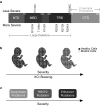Treating Rett syndrome: from mouse models to human therapies
- PMID: 30820643
- PMCID: PMC6606665
- DOI: 10.1007/s00335-019-09793-5
Treating Rett syndrome: from mouse models to human therapies
Abstract
Rare diseases are very difficult to study mechanistically and to develop therapies for because of the scarcity of patients. Here, the rare neuro-metabolic disorder Rett syndrome (RTT) is discussed as a prototype for precision medicine, demonstrating how mouse models have led to an understanding of the development of symptoms. RTT is caused by mutations in the X-linked gene methyl-CpG-binding protein 2 (MECP2). Mecp2-mutant mice are being used in preclinical studies that target the MECP2 gene directly, or its downstream pathways. Importantly, this work may improve the health of RTT patients. Clinical presentation may vary widely among individuals based on their mutation, but also because of the degree of X chromosome inactivation and the presence of modifier genes. Because it is a complex disorder involving many organ systems, it is likely that recovery of RTT patients will involve a combination of treatments. Precision medicine is warranted to provide the best efficacy to individually treat RTT patients.
Conflict of interest statement
All authors declare that they have no conflict of interest.
Figures




References
-
- Alpoz AR, Ergul N, Oncag O. Bruxism in Rett syndrome: a case report. J Clin Pediatr Dent. 1999;23:161–163. - PubMed
Publication types
MeSH terms
Substances
Grants and funding
LinkOut - more resources
Full Text Sources
Other Literature Sources
Medical

